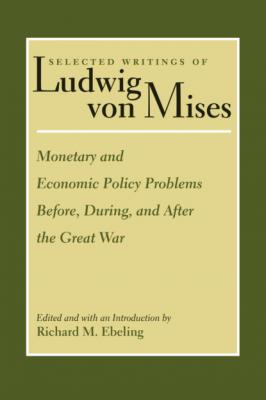Monetary and Economic Policy Problems Before, During, and After the Great War. Людвиг фон Мизес
Читать онлайн.| Название | Monetary and Economic Policy Problems Before, During, and After the Great War |
|---|---|
| Автор произведения | Людвиг фон Мизес |
| Жанр | Экономика |
| Серия | Selected Writings of Ludwig von Mises |
| Издательство | Экономика |
| Год выпуска | 0 |
| isbn | 9781614872535 |
The belief that lay behind the excessive emphasis on the importance of the “relation” in agricultural circles and among commercial manufacturers and the scientific discussions about the currency question (the suspense with which the market followed the battle between the light and heavy florins requires no further explanation) was that the value of money in domestic commerce would not, or would not immediately, change according to the change in the value of the currency on the global market. Or, in other words, it was considered possible, with the transfer to the new currency system, to “eternalize” the currency differential between the Austrian currency and those of the gold currency countries. This view is based, however, on an error. Sooner or later, the prices of all domestic goods and services will adjust to the change in value of money, and the advantages that a devalued currency offers to production, and the obstacles that an overvalued one sets against production, will disappear. This is because the agio as such does not function as an export premium or as a protective tariff; rather, it is merely the increasing agio, or inversely only the decreasing agio, not the low agio in itself, that is able to check exports and boost imports.
The importance of currency policy in relation to currency reform did not lie in the higher or lower “relation,” but rather in that the monarchy converted from a monetary system with a currency that was increasing in value compared with the currencies of the economic Great Powers, to a monetary system with a currency that was stable abroad.
The Act of August 2, 1892, admittedly only arrested the increase in the value of the Austrian currency. Since August 11, 1892, the day that it came into effect, the value of the Austrian florin (2 crowns) essentially cannot rise above the value of 2 francs, 10 centimes or 1 mark, 70.12 pfennig. In contrast, no legal barricade was placed against a decrease in the value of money. This should become impossible in the future due to the implementation of specie payments, which was considered by the creators of the reform act to be its conclusion.
It is certain that the implementation of specie payments was initially postponed only because for its assurance sufficient provisions, most notably the accumulation of a correspondingly large stockpile of precious metal in the bank’s vaults, were necessary, and a favorable configuration of circumstances on the international currency markets had to be awaited. However, it also appeared just as certain that, precisely due to the fact that only a further increase in the value of money had been made provisionally impossible by the adoption of the draft reform, the chance of a possible decrease in the value of money, if one might even discuss such a thing, by contrast remained open, and had assisted in the victory of the reform project. By agreeing to currency reform, the friends of “cheap money” sacrificed nothing and won a great deal: the establishment of an upper limit to the value of money.
The further fate of currency reform admittedly has turned out differently than even the most highly informed circles could have predicted in 1892. After the events on the international currency market in 1893 and 1896 had placed the success of currency reform in doubt, the foreign exchange policy of the Austro-Hungarian Bank, inaugurated in 1896, established the stability of the currency, including a lower limit. It should be noted, however, that this bank policy, initially suggested in 1894 by the then Austrian Finance Minister Ernst von Plener,53 resulted absolutely from the initiative of governmental agencies that were accommodating the desires of the business world. Up until now, it had undergone neither an exhaustive parliamentary criticism nor a corresponding appraisal from the political parties.
Only through the bank’s intervention on the foreign exchange market was the stabilization of the price of the Austrian currency achieved on both ends, and thereby the currency question was solved for the monarchy. Whether specie payments are to be implemented or not is a question of expediency and of the discount policy, in which currency policy considerations play only a limited role. No rational person on this or the other side of the Leitha54 would advocate today against the gold currency.
Конец ознакомительного фрагмента.
Текст предоставлен ООО «ЛитРес».
Прочитайте эту книгу целиком, купив полную легальную версию на ЛитРес.
Безопасно оплатить книгу можно банковской картой Visa, MasterCard, Maestro, со счета мобильного телефона, с платежного терминала, в салоне МТС или Связной, через PayPal, WebMoney, Яндекс.Деньги, QIWI Кошелек, бонусными картами или другим удобным Вам способом.
